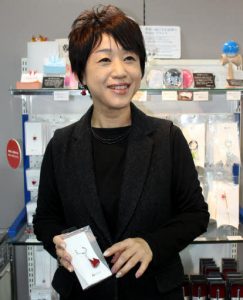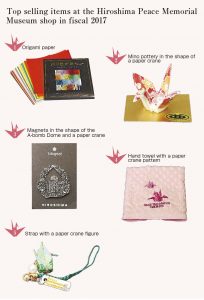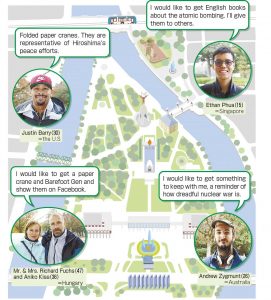Peace Seeds: Teens in Hiroshima Sow Seeds of Peace (Part 64)
Jan. 17, 2019
Part 64: Souvenirs of the A-bombed city of Hiroshima
When tourists visit the A-bombed city of Hiroshima, what kinds of souvenirs from Hiroshima do they buy and why do they buy them?
The number of visitors from overseas is also growing. The junior writers of the Chugoku Shimbun gathered information from international visitors at the Hiroshima Peace Memorial Park, asking them what kinds of items they want. We also explored which items are selling well and what new items are being produced.
When visitors give souvenirs to people, they are able to convey to them the feelings they felt while in Hiroshima. In that sense, we think that souvenirs from Hiroshima aren’t merely material goods, they also play an important role in spreading the message of peace.
Speaking to international visitors in the Peace Memorial Park
Six junior writers asked international visitors in the park what kinds of souvenirs they wanted to get. Fifteen groups of people from ten countries, traveling individually or in a group, responded to our questions.
The respondents were from Canada, the United States, Mexico, Australia, New Zealand, Russia, Singapore, Qatar, France, and Hungary. Four groups of people offered the most common response, saying that they wanted folded paper cranes because the paper crane is a symbol of peace and important to promoting peace in the world. Some said they would give the cranes to others and talk about their experience in Hiroshima; some said they would put a crane in an important place where could regularly see it. These responses show how the story of Sadako Sasaki and her paper cranes has spread across the world.
We had assumed that paper cranes were simply made and offered by visitors to the park. But they might also be something for visitors to bring back to their countries with them. Perhaps paper cranes can serve as a reminder, too, so international visitors can keep the A-bombed city of Hiroshima in mind.
Other visitors said, “I’ll give people the books I bought, and tell them about the horror of nuclear weapons” or “Through this A-bomb Dome ornament, I want to convey not only the tragedy of the bombing, but also the importance of never giving up on reconstruction efforts.” Further responses included sharing the photos they took themselves, and their experience touring the Peace Memorial Museum, rather than buying souvenirs.
The souvenirs that visitors bring back to their home countries from Hiroshima are used in a variety of ways. We found that the same items hold different meanings to different people. (Miyuu Okada, 17, Honoka Ikeda, 18, Yoshiko Hirata, 17, Riho Kito, 17, Ayu Hayashida, 14, and Yuna Okajima, 14)
Hiroshima Peace Memorial Museum shop carries 230 different items
Many people visit the shop at the Hiroshima Peace Memorial Museum each day. The Hiroshima Peace Culture Foundation manages the shop, which carries around 230 different items, including books, DVDs, and T-shirts. The most popular items in fiscal 2017 were origami paper and products related to paper cranes.
In fiscal 1983, when the foundation took over the shop, products like books and picture postcards were being sold. After that, the variety of goods increased. Lately, the number of items made from recycled paper from paper cranes has been growing. Akinori Ito, 47, the assistant manager of the foundation’s general affairs section, said, “I would like visitors to remember that they visited the Peace Memorial Museum when they see their souvenirs and think about our wish for peace.”
A mailbox was installed in the museum in 2006, and visitors can buy postcards at the shop and send them to family or friends with the postmark of the Cenotaph for the A-bomb Victims, among other postmarks. I felt that these visitors would surely think more about their desire for peace and convey a message of peace to the people getting their postcards. (Miki Meguro, 15)
Interview with Chizuru Gorai, founder of EARTH Hiroshima
The brand EARTH Hiroshima brings Hiroshima-based designers and manufacturers together to create souvenirs that can promote the desire for peace. We spoke to Chizuru Gorai, 55, the president of Soar Service Inc., located in Naka Ward, and the brainchild of EARTH Hiroshima.
This origin of this effort began when Ms. Gorai attended a Peace Memorial Ceremony on August 6 when she was in her 30s. She was struck by the sight of so many people praying for peace. At the same time, the area outside the park was crowded with shoppers and Ms. Gorai became intent on bridging the boundary between these two groups of people.
The brand was launched in 2016 and there are now more than 30 items, including plastic key chains and earrings in the shape of paper cranes and cosmetic brushes made in Kumano with decorative illustrations of paper cranes. These products are all so lovely that we were eager to hold them in our hands.
Ms. Gorai, a second-generation A-bomb survivor, explained, “I hope that people who get these souvenirs will have warm feelings and will be encouraged to remember peace in their daily lives.” We realized that souvenirs are one way of expressing our desire for peace. It is important to buy souvenirs not merely as mementos, but to grasp the message of peace that they contain. (Honoka Ikeda, 18, and Yuna Okajima, 14)
Origin of Hiroshima souvenirs came from postcards sold by survivor
The origin of souvenirs from Hiroshima can apparently be traced back to the late Kiyoshi Kikkawa. In 1951, he opened a souvenir stand near the A-bomb Dome that sold picture postcards and other items. By reading Genbaku Ichigo to Iwarete (Atomic Bomb Victim No. 1), a book written by Mr. Kikkawa, and articles about him from the Chugoku Shimbun, I was able to learn about what he was thinking at the time.
When Mr. Kikkawa was in the hospital after the bombing, American reporters saw the keloid scars on his back and referred to him as “Atomic Bomb Victim No. 1.” The nickname then stuck. After being discharged from the hospital, it was difficult for him to find work so he opened the souvenir stand on someone’s suggestion. His sales on the first day came to 250 yen and this enabled him to buy rice and vegetables. It was the first time that he could eat until he was full since experiencing the A-bomb attack.
He continued to show his keloid scars to visitors and tell about the horror of the atomic bombing. Some people criticized him, saying that he was taking advantage of the atomic bombing for personal gain, but he stressed that he cursed nuclear weapons. Mr. Kikkawa created the first organization for A-bomb survivors in Hiroshima, and he is known for his dedication to efforts to carry out the group’s antinuclear activities. I felt the strength embodied by Mr. Kikkawa, who had to struggle through so much hardship in the aftermath of the war. (Miki Meguro, 15)
What is Peace Seeds?
Peace Seeds are the seeds of smiles which can be spread around the world by thinking about peace and the preciousness of life from various viewpoints. To fill this world with flowering smiles, 21 junior writers (junior high school and senior high school students), choose themes, gather information, and write articles.
(Originally published on January 17, 2019)
When tourists visit the A-bombed city of Hiroshima, what kinds of souvenirs from Hiroshima do they buy and why do they buy them?
The number of visitors from overseas is also growing. The junior writers of the Chugoku Shimbun gathered information from international visitors at the Hiroshima Peace Memorial Park, asking them what kinds of items they want. We also explored which items are selling well and what new items are being produced.
When visitors give souvenirs to people, they are able to convey to them the feelings they felt while in Hiroshima. In that sense, we think that souvenirs from Hiroshima aren’t merely material goods, they also play an important role in spreading the message of peace.
Speaking to international visitors in the Peace Memorial Park
Six junior writers asked international visitors in the park what kinds of souvenirs they wanted to get. Fifteen groups of people from ten countries, traveling individually or in a group, responded to our questions.
The respondents were from Canada, the United States, Mexico, Australia, New Zealand, Russia, Singapore, Qatar, France, and Hungary. Four groups of people offered the most common response, saying that they wanted folded paper cranes because the paper crane is a symbol of peace and important to promoting peace in the world. Some said they would give the cranes to others and talk about their experience in Hiroshima; some said they would put a crane in an important place where could regularly see it. These responses show how the story of Sadako Sasaki and her paper cranes has spread across the world.
We had assumed that paper cranes were simply made and offered by visitors to the park. But they might also be something for visitors to bring back to their countries with them. Perhaps paper cranes can serve as a reminder, too, so international visitors can keep the A-bombed city of Hiroshima in mind.
Other visitors said, “I’ll give people the books I bought, and tell them about the horror of nuclear weapons” or “Through this A-bomb Dome ornament, I want to convey not only the tragedy of the bombing, but also the importance of never giving up on reconstruction efforts.” Further responses included sharing the photos they took themselves, and their experience touring the Peace Memorial Museum, rather than buying souvenirs.
The souvenirs that visitors bring back to their home countries from Hiroshima are used in a variety of ways. We found that the same items hold different meanings to different people. (Miyuu Okada, 17, Honoka Ikeda, 18, Yoshiko Hirata, 17, Riho Kito, 17, Ayu Hayashida, 14, and Yuna Okajima, 14)
Hiroshima Peace Memorial Museum shop carries 230 different items
Many people visit the shop at the Hiroshima Peace Memorial Museum each day. The Hiroshima Peace Culture Foundation manages the shop, which carries around 230 different items, including books, DVDs, and T-shirts. The most popular items in fiscal 2017 were origami paper and products related to paper cranes.
In fiscal 1983, when the foundation took over the shop, products like books and picture postcards were being sold. After that, the variety of goods increased. Lately, the number of items made from recycled paper from paper cranes has been growing. Akinori Ito, 47, the assistant manager of the foundation’s general affairs section, said, “I would like visitors to remember that they visited the Peace Memorial Museum when they see their souvenirs and think about our wish for peace.”
A mailbox was installed in the museum in 2006, and visitors can buy postcards at the shop and send them to family or friends with the postmark of the Cenotaph for the A-bomb Victims, among other postmarks. I felt that these visitors would surely think more about their desire for peace and convey a message of peace to the people getting their postcards. (Miki Meguro, 15)
Interview with Chizuru Gorai, founder of EARTH Hiroshima
The brand EARTH Hiroshima brings Hiroshima-based designers and manufacturers together to create souvenirs that can promote the desire for peace. We spoke to Chizuru Gorai, 55, the president of Soar Service Inc., located in Naka Ward, and the brainchild of EARTH Hiroshima.
This origin of this effort began when Ms. Gorai attended a Peace Memorial Ceremony on August 6 when she was in her 30s. She was struck by the sight of so many people praying for peace. At the same time, the area outside the park was crowded with shoppers and Ms. Gorai became intent on bridging the boundary between these two groups of people.
The brand was launched in 2016 and there are now more than 30 items, including plastic key chains and earrings in the shape of paper cranes and cosmetic brushes made in Kumano with decorative illustrations of paper cranes. These products are all so lovely that we were eager to hold them in our hands.
Ms. Gorai, a second-generation A-bomb survivor, explained, “I hope that people who get these souvenirs will have warm feelings and will be encouraged to remember peace in their daily lives.” We realized that souvenirs are one way of expressing our desire for peace. It is important to buy souvenirs not merely as mementos, but to grasp the message of peace that they contain. (Honoka Ikeda, 18, and Yuna Okajima, 14)
Origin of Hiroshima souvenirs came from postcards sold by survivor
The origin of souvenirs from Hiroshima can apparently be traced back to the late Kiyoshi Kikkawa. In 1951, he opened a souvenir stand near the A-bomb Dome that sold picture postcards and other items. By reading Genbaku Ichigo to Iwarete (Atomic Bomb Victim No. 1), a book written by Mr. Kikkawa, and articles about him from the Chugoku Shimbun, I was able to learn about what he was thinking at the time.
When Mr. Kikkawa was in the hospital after the bombing, American reporters saw the keloid scars on his back and referred to him as “Atomic Bomb Victim No. 1.” The nickname then stuck. After being discharged from the hospital, it was difficult for him to find work so he opened the souvenir stand on someone’s suggestion. His sales on the first day came to 250 yen and this enabled him to buy rice and vegetables. It was the first time that he could eat until he was full since experiencing the A-bomb attack.
He continued to show his keloid scars to visitors and tell about the horror of the atomic bombing. Some people criticized him, saying that he was taking advantage of the atomic bombing for personal gain, but he stressed that he cursed nuclear weapons. Mr. Kikkawa created the first organization for A-bomb survivors in Hiroshima, and he is known for his dedication to efforts to carry out the group’s antinuclear activities. I felt the strength embodied by Mr. Kikkawa, who had to struggle through so much hardship in the aftermath of the war. (Miki Meguro, 15)
What is Peace Seeds?
Peace Seeds are the seeds of smiles which can be spread around the world by thinking about peace and the preciousness of life from various viewpoints. To fill this world with flowering smiles, 21 junior writers (junior high school and senior high school students), choose themes, gather information, and write articles.
(Originally published on January 17, 2019)










